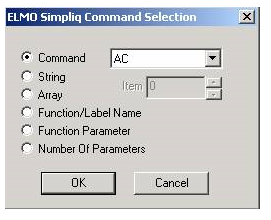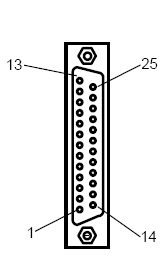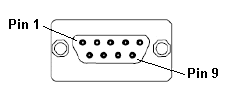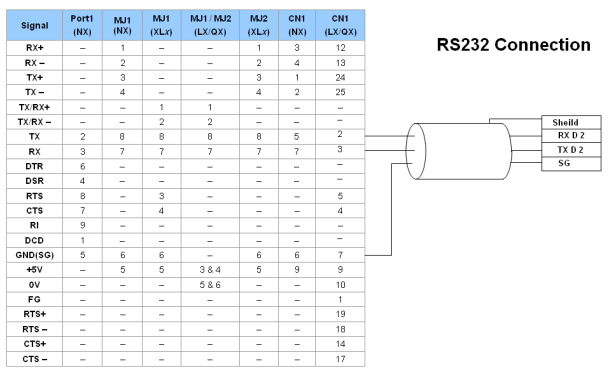ELMO Protocol
See also: Help for Serial Protocols
Overview
The ELMO SimpliQ serial downloadable protocol is for communication between the ELMO SimpliQ drives and an OCS. This is a Master/Slave protocol.
CSCAPE Configuration
To configure OCS for the ELMO protocol, select the Protocol Configuration from the Program menu in CSCAPE software. Select the appropriate protocol type on the desired port. To make sure that the Software is able to configure the equipment for the correct protocol, ensure Elmo.dll file is in the Protocols directory of the current working/open Cscape.
Protocol Revisions
ELMO SimpliQ Protocol supports master communications to the slave using ASCII commands.
Serial Port Format
The default link settings are : 19200 baud, No parity, Eight data bits, RS232 Communication and No handshaking.
Communications is via the COM1 port located on the side of the unit.
ECHO command
On boot up of the OCS, the ECHO is set to ECHO_OFF. This is because on boot up the device does not know what the drive is set to. So to make sure the echo is on, ECHO_ON command must be set.
NOTE: ECHO needs to be ON at all times for this Serial Protocol to work.
Commands
Each drive parameter is accessed as a command. These commands are explained in the following section. When these commands are being accessed in CSCAPE the name of each command may be directly used.
Commands have a number of different set ups, including arrays and strings. The ELMO commands supported by the OCS are given in the following section.
NOTE: The data type of each command is important. Every command must be configured as a 32-bit memory location for accessibility reasons i.e. even if the command is 8-bit, 16-bit or 32-bit the register must be given 32-bit of memory space. So if %R1 contains one command, %R3 should be used not %R2 for the next command.
Description of the DLL for use with the OCS range in CSCAPE
From the Scan List Data Mapping Section in Protocol Configuration the user is prompted to enter the register type to be accessed.

From the bullet point list the register type can be selected:
-
Command
-
String
-
Array
-
Function/Label Name
-
Function Parameter
-
Number of Parameters
Command - These register types access all commands as numeric entries. It is important to note however, that correct selection of the data type is necessary for the command to be received and transmitted correctly.
Arrays - These work in a similar fashion to the Commands with the only difference being the Index into the array being selectable. “xxxxx.y” is the format it takes with y being the index of the array and x being the command name.
Strings - Accessed as a single command. It is important to scan for the correct amount of consecutive characters. A block of 1 will produce 4 ASCII characters. There are only 3 strings may be accessed.
Function/Label Name - This register type allows to enter an ASCII string for use with the XQ command. There are 3 options with XQ command:
- XQ##
- XQ##LABEL
- XQ##MYFUNCTION(a,b,c)
For the LABEL name or the FUNCTION name simply write the string to access and then using the XQ command, this string gets sent appropriately.
If the String area is blank i.e. no text, then nothing gets sent, i.e. XQ## is sent.
Function Parameter - There are 3 function parameters. If the user wishes to send the XQ##MYFUNCTION (a,b,c) command then simply set these values 0, 1 and 2 correctly and then send the XQ command.
Number of Parameters - The user enters the number of parameters they wish to use with the XQ##MYFUNCTION (a,b,c) command. If this is set to 0, then the XQ##LABEL is used without the parameters. Setting this to 1, 2 or 3 sends that amount of parameters.
Network Communication Errors
In order to access the Network statistics, user must assign the “Network status register” in network configuration. The table below gives the details of statistics.
| Number | Statistics | Location | Description |
|---|---|---|---|
|
|
|
|
|
|
1 |
Update interval exceeded count |
%Rx |
This register explains number of times that the actual transaction scan time to complete all transactions exceeded specified update interval. Generally used as an indicator that an excessive number of triggered transfers or failed communication retries are occurring that is lengthening the expected transaction scan time.
If the Update interval is set to zero (update as fast as possible), this 32-bit register alternately specifies the actual transaction scan time in mSec resolution. |
|
2 |
No response count |
%R(x+2) |
This register explains number of times that a device(s) did not respond to a transaction. This includes ALL failed transaction, not just those after the retry count is exceeded. |
|
3 |
Corrupt Response Count |
%R(x+4) |
This register explains number of times that a device(s) returned an invalid or failed response to a transaction. This includes ALL failed.
Transaction, not just those after the retry count is exceeded. |
|
4 |
Valid Response Count |
%R(x+6) |
This register explains total number of valid responses. |
NOTE: %Rx: 32-bit network status register configured in Network configuration. For example: %R500(501).
Device Communication Errors
| Error | Error Number | Description |
|---|---|---|
|
INVALID_BLOCK |
-203 |
Invalid size for data type. |
|
NO_RESPONSE_FROM_PLC |
-204 |
Timeout while waiting for remote node response. |
|
INVALID_RESPONSE_FROM_PLC |
-205 |
Corrupted response from remote node. |
|
INVALID_INITIALISATION |
-207 |
Internal Error - Unable to open port. |
Connection Details
Illustrations below show the various end-of-cable connectors required:
| 25-Pin D-Type Male | 10-Pin Weidmuller
Cage Clamp |
8-Pin RJ 45 Plug | 9-Pin DB Male |

|

|

|

|
| CN1 | CN1 | MJ1/MJ2 | Port 1 |

Port 1 — DB9 (Female at OCS end)
MJ1/MJ2 — RJ45 (Female at OCS end)
CN1 — 10-Pin Weidmuller Cage Clamp (Female at OCS end)
CN1 — DB25 (Female at OCS end)
NOTES:
-
Do not connect to unlisted pins.
-
Recommended Cable: Beldon 9503, twisted multipair, screened.
-
Connect the screens together at the shield / earth pin of the PLC.